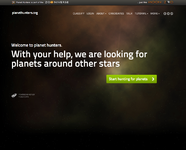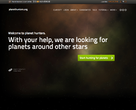|
|
| (One intermediate revision by one other user not shown) |
| Line 4: |
Line 4: |
| |field_screenshot=Capture d’écran 2013-11-14 à 14.29.40.png | | |field_screenshot=Capture d’écran 2013-11-14 à 14.29.40.png |
| |field_infrastructure=Zooniverse | | |field_infrastructure=Zooniverse |
| |field_project_open=No | | |field_project_open=Yes |
| |field_subject_areas=Natural sciences | | |field_subject_areas=Natural sciences |
| |field_cs_subject_areas=physics | | |field_cs_subject_areas=physics |
| Line 22: |
Line 22: |
| |field_volonteer_sensing=no | | |field_volonteer_sensing=no |
| |field_volonteer_gaming=no | | |field_volonteer_gaming=no |
| |field_tutorials_documentation=N/A | | |field_data_types_to_manipulate=observations, other |
| |field_peer_to_peer_guidance=N/A | | |field_other_data_types_to_manipulate=graphs |
| |field_training_sequence=N/A | | |field_participant_contribution_type=data interpretation |
| |field_individual_performance_feedback=N/A | | |field_interaction_with_objects=Draw boxes around parts of the graph that represent "dips" |
| | |field_interface_attractivity=cool/attractive |
| | |field_interface_usability=easy to use |
| | |field_tutorials_documentation=yes |
| | |field_peer_to_peer_guidance=no |
| | |field_training_sequence=no |
| | |field_individual_performance_feedback=yes |
| |field_collective_performance_feedback=N/A | | |field_collective_performance_feedback=N/A |
| |field_research_progress_feedback=N/A | | |field_research_progress_feedback=somewhat |
| |field_member_profiles=N/A | | |field_member_profiles=N/A |
| | |field_community_tools=forum |
| |field_has_community_manager=N/A | | |field_has_community_manager=N/A |
| |field_project_news_updates=N/A | | |field_project_news_updates=N/A |
| |field_socialsoftware_sites=N/A | | |field_socialsoftware_sites=N/A |
| |field_team_work=N/A | | |field_team_work=N/A |
| | |field_completion_level=Medium |
| |field_last_edition=2013/11/14 | | |field_last_edition=2013/11/14 |
| }} | | }} |
|
| |
|
| {{Free text}} | | {{Free text}} |
Cs Portal > List of citizen science projects > Planet Hunters - (2013/11/14)
THIS PAGE DESCRIBE A CITIZEN SCIENCE PROJECT
Start date :
- Beta start date : N/A
- End date : Still open.
⇳ Description
Planet Hunters, the latest project from the Zooniverse, is a citizen science project. Participants help us sieve through data taken by the NASA Kepler space mission. These data consist of brightness measurements, or "light curves," taken every thirty minutes for more than 150,000 stars. Users search for possible transit events - a brief dip in brightness that occurs when a planet passes in front of the star - with the goal of discovering a planet (hence the name "Planet Hunters"). The most difficult detections for Planet Hunters and for computer-based searches will be those from planets that orbit far from their star and therefore cross the star infrequently. It may also be difficult for computer algorithms to detect planets in data that has artificial offsets (which can occur with telescope pointing errors or space craft rolls). Planet Hunter participants may be better than computers at finding signals in this type of data. Because of the outstanding pattern recognition of the human brain, we hope that participants will also establish new "families" or classifications for the light curves. We will be standing by to obtain more data at telescopes to better understand the underlying physical reason for the different classifications.
➠ Purpose
The Kepler team has been developing computer algorithms to analyze light curve data because it is not possible for them to visually inspect every light curve. While we expect computer programs to robustly identify things that they are trained to find, we are betting that there will be a number of surprises in the data that the computer algorithms will miss.
The human brain is particularly good at discerning patterns or aberrations and experiments have shown that when many people work together, the collective wisdom of the crowds can be better than an expert. Planet Hunters is an online experiment that taps into the power of human pattern recognition. Participants are partners with our science team, who will analyze group assessments, obtain follow up observations at the telescope to understand the new classification schemes for different families of light curves, identify oddities, and verify transit signals.
? Research question
NASA's Kepler spacecraft is one of the most powerful tools in the hunt for extrasolar planets. The Kepler team's computers are sifting through the data, but we at Planet Hunters are betting that there will be planets which can only be found via the remarkable human ability for pattern recognition.
This is a gamble, a bet if you will, on the ability of humans to beat machines just occasionally. It may be that no new planets are found or that computers have the job down to a fine art. And yet, it's just possible that you might be the first to know that a star somewhere out there in the Milky Way has a companion, just as our Sun does. Fancy giving it a try?
MAIN TEAM LOCATION
Loading map...
{"minzoom":false,"maxzoom":false,"mappingservice":"leaflet","width":"300px","height":"270px","centre":false,"title":"","label":"","icon":"","lines":[],"polygons":[],"circles":[],"rectangles":[],"copycoords":false,"static":false,"zoom":false,"defzoom":14,"layers":["OpenStreetMap"],"image layers":[],"overlays":[],"resizable":false,"fullscreen":false,"scrollwheelzoom":true,"cluster":false,"clustermaxzoom":20,"clusterzoomonclick":true,"clustermaxradius":80,"clusterspiderfy":true,"geojson":"","clicktarget":"","imageLayers":[],"locations":[],"imageoverlays":null}
CONTRIBUTION TYPE: data interpretation
PARTICIPATION TYPOLOGY:
GAMING GENRE NONE
GAMING ELEMENTS: NONE
◉ Tasks description
⤯ Interaction with objects
Draw boxes around parts of the graph that represent "dips"
▣ Interface
- Data type to manipulate: observations, other
- interface enjoyment: cool/attractive
- Interface usability: easy to use
GUIDANCE
- Tutorial: ✓
- Peer to peer guidance: x
- Training sequence: x
FEEDBACK ON
- Individual performance: ✓
- Collective performance: Somewhat
- Research progress: Somewhat
❂ Feedback and guidance description
COMMUNITY TOOLS
- Communication: forum
- Social Network: N/A
- Member profiles:: N/A
- Member profile elements:
NEWS & EVENTS
- Main news site:
- Frequency of project news updates: N/A
- Type of events:
- Frequency of events :
⏣ Community description
- Community size (volounteers based)
- Role:
- Interaction form:
- Has official community manager(s): N/A
- Has team work N/A
- Other:
- Community led additions:
Other information
PROJECT
Url:http://www.planethunters.org/
Start date:
End date: Still open
Infrastructure: Zooniverse
TEAM
Official team page:http://www.planethunters.org/who_we_are#Beleu
Leader: Michele Beleu
Institution: Yale Universuty
Partner institutions: Adler Planetarium, Univeristy of Oxform, Vizzuality, Zooinverse
Contact: http://www.planethunters.org/who_we_are#forum
PROJECT DEFINITION
Subject
Natural sciences > astronomy, astrophyics (physics)
Description
Planet Hunters, the latest project from the Zooniverse, is a citizen science project. Participants help us sieve through data taken by the NASA Kepler space mission. These data consist of brightness measurements, or "light curves," taken every thirty minutes for more than 150,000 stars. Users search for possible transit events - a brief dip in brightness that occurs when a planet passes in front of the star - with the goal of discovering a planet (hence the name "Planet Hunters"). The most difficult detections for Planet Hunters and for computer-based searches will be those from planets that orbit far from their star and therefore cross the star infrequently. It may also be difficult for computer algorithms to detect planets in data that has artificial offsets (which can occur with telescope pointing errors or space craft rolls). Planet Hunter participants may be better than computers at finding signals in this type of data. Because of the outstanding pattern recognition of the human brain, we hope that participants will also establish new "families" or classifications for the light curves. We will be standing by to obtain more data at telescopes to better understand the underlying physical reason for the different classifications.
Purpose.
The Kepler team has been developing computer algorithms to analyze light curve data because it is not possible for them to visually inspect every light curve. While we expect computer programs to robustly identify things that they are trained to find, we are betting that there will be a number of surprises in the data that the computer algorithms will miss.
The human brain is particularly good at discerning patterns or aberrations and experiments have shown that when many people work together, the collective wisdom of the crowds can be better than an expert. Planet Hunters is an online experiment that taps into the power of human pattern recognition. Participants are partners with our science team, who will analyze group assessments, obtain follow up observations at the telescope to understand the new classification schemes for different families of light curves, identify oddities, and verify transit signals.
Research question.
NASA's Kepler spacecraft is one of the most powerful tools in the hunt for extrasolar planets. The Kepler team's computers are sifting through the data, but we at Planet Hunters are betting that there will be planets which can only be found via the remarkable human ability for pattern recognition.
This is a gamble, a bet if you will, on the ability of humans to beat machines just occasionally. It may be that no new planets are found or that computers have the job down to a fine art. And yet, it's just possible that you might be the first to know that a star somewhere out there in the Milky Way has a companion, just as our Sun does. Fancy giving it a try?
ABOUT PARTICIPANT TASKS
.
Interaction with system objects.
Draw boxes around parts of the graph that represent "dips"
| Grey typology |
Participation typology |
Contribution type: |
|
|
| Computing: |
NO |
Thinking: |
NO |
| Sensing: |
NO |
Gaming: |
NO |
|
|
|
| Crowdsourcing |
☐ |
Distributed intelligence |
☐ |
| Participatory science |
☐ |
Extreme citizen science |
☐ |
| Science outreach |
☐ |
| |
|
| Data collection |
☐ |
| Data analysis |
☐ |
| Data interpretation |
☑-------- |
|
| Gaming |
| Genre: |
Gaming elements: |
| Interface |
| Data type to manipulate: observations, other |
interface enjoyment: cool/attractive
Interface usability: easy to use |
Member profiles::N/A
Member profile elements: |
ABOUT GUIDANCE AND FEEDBACK
| Guidance |
Feedback on |
| Tutorial and documentation: |
YES |
| Training sequence: |
NO |
| Peer to peer guidance: |
NO |
|
| individual performance: |
YES |
| collective performance: |
Somewhat |
| research progress: |
Somewhat |
|
.
| Tools |
News & Events |
|
Communication: forum
Social Network: N/A
|
Main news site:
Frequency of project news updates: N/A
Type of events:
Frequency of events :
|
| Community description |
|
Community size (volounteers based):
Role:
Interaction form:
Has official community manager(s): N/A
Has team work N/A
|
Other information about community:
Community led additions:
OTHER PROJECT INFORMATION
Capture d’écran 2013-11-14 à 14.29.40.png
Yes
[[has completion level::Medium]
http://www.planethunters.org/who we are#Beleu
http://www.planethunters.org/who we are#forum
Yes
astronomy, astrophyics
Natural sciences
physics
The Kepler team has been developing computer algorithms to analyze light curve data because it is not possible for them to visually inspect every light curve. While we expect computer programs to robustly identify things that they are trained to find, we are betting that there will be a number of surprises in the data that the computer algorithms will miss.
The human brain is particularly good at discerning patterns or aberrations and experiments have shown that when many people work together, the collective wisdom of the crowds can be better than an expert. Planet Hunters is an online experiment that taps into the power of human pattern recognition. Participants are partners with our science team, who will analyze group assessments, obtain follow up observations at the telescope to understand the new classification schemes for different families of light curves, identify oddities, and verify transit signals.
NASA's Kepler spacecraft is one of the most powerful tools in the hunt for extrasolar planets. The Kepler team's computers are sifting through the data, but we at Planet Hunters are betting that there will be planets which can only be found via the remarkable human ability for pattern recognition.
This is a gamble, a bet if you will, on the ability of humans to beat machines just occasionally. It may be that no new planets are found or that computers have the job down to a fine art. And yet, it's just possible that you might be the first to know that a star somewhere out there in the Milky Way has a companion, just as our Sun does. Fancy giving it a try?
Planet Hunters
data interpretation
observations, other, other: graphs
Thinking: no
Computing: no
Sensing: no
Gaming: no
Draw boxes around parts of the graph that represent "dips"
cool/attractive
easy to use
yes
no
no
yes
N/A
somewhat
N/A
N/A
forum
N/A
N/A
N/A
Medium
Bibliography



